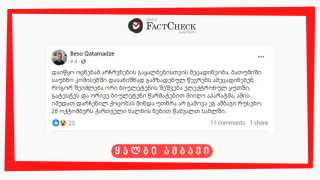Disinformation: Electoral machines can accept two ballots
Verdict: FAKE NEWS
Member of the Ozurgeti Municipality Assembly, Beso Katamadze, published a social media post, alleging the possibility of election fraud at the 26 October parliamentary elections (archived link). “The Georgian Dream has commenced preparations for election fraud. They were teaching the Batumi Electoral Commission representatives how it is possible to register two ballots in the voting device, successfully testing it, as the device indeed accepted both ballots. I would like to inform the Georgian Dream that this approach will not work, you Russians. You will have to go home on 26 October as per the Georgian people’s wishes” - reads the social media post.

The aforementioned claim, alleging that the vote-counting machine can simultaneously accept two ballots, is disinformation. The vote-counting machine is technically unable to accept and scan two ballots at the same time. Furthermore, the registrar hands over one ballot to the voter after registering and the voting procedure is closely overseen by local and international organisations and political party representatives.
Whilst the electorate will not have more than one ballot, we can assume that a voter somehow acquired two ballots for analysis purposes. Even in this case, it is still impossible to place two ballots into the scanner device simultaneously. The voter would have to insert one of the ballots into the machine first and wait for the scanner to accept it, only being able to place the second ballot into the machine after the first one. This is practically impossible as several observers oversee the electoral process.
FactCheck contacted the Central Election Commission (CEC) to assess the aforementioned claim. The CEC explains that the device is programmed in a way that makes it impossible to scan more than one ballot. The scanner mechanism of the vote-counting machine is physically unable to accept more than one ballot. The device screen will display a text noting that the machine was unable to receive the ballot in case such an attempt occurs.
The CEC states that the electoral precinct members are currently undergoing training to improve their qualifications. Furthermore, an information campaign, Demonstrating Electoral Technologies, is being conducted for the electorate. Notably, any individual can double-check that the vote-counting machine cannot receive two ballots during this campaign.
Additionally, the efficiency of electronic technologies is confirmed by relevant audits. Pro V&V, a company registered and accredited in the USA, conducted an audit of the use of digital devices at the initiative of the Central Election Commission. Pro V&V observed vote-counting machines at six polling stations during the 1 October electronic mid-term/special election, verifying that: a) each vote equals one vote and one vote only and b) the electronic voting system accurately assigns each voter the appropriate number of votes (one), securely stores this information in the electronic ballot box and ensures that is it accurately reflected in the election results.
Thus, the claim that two ballots can be inserted into the electoral machine to falsify the election is not true as this is technically impossible. The vote-counting machine can only receive and scan one ballot at a time. Here, we offer the video material confirming the conclusion above which was filmed by FactCheck at the demonstration meeting of election technologies.







